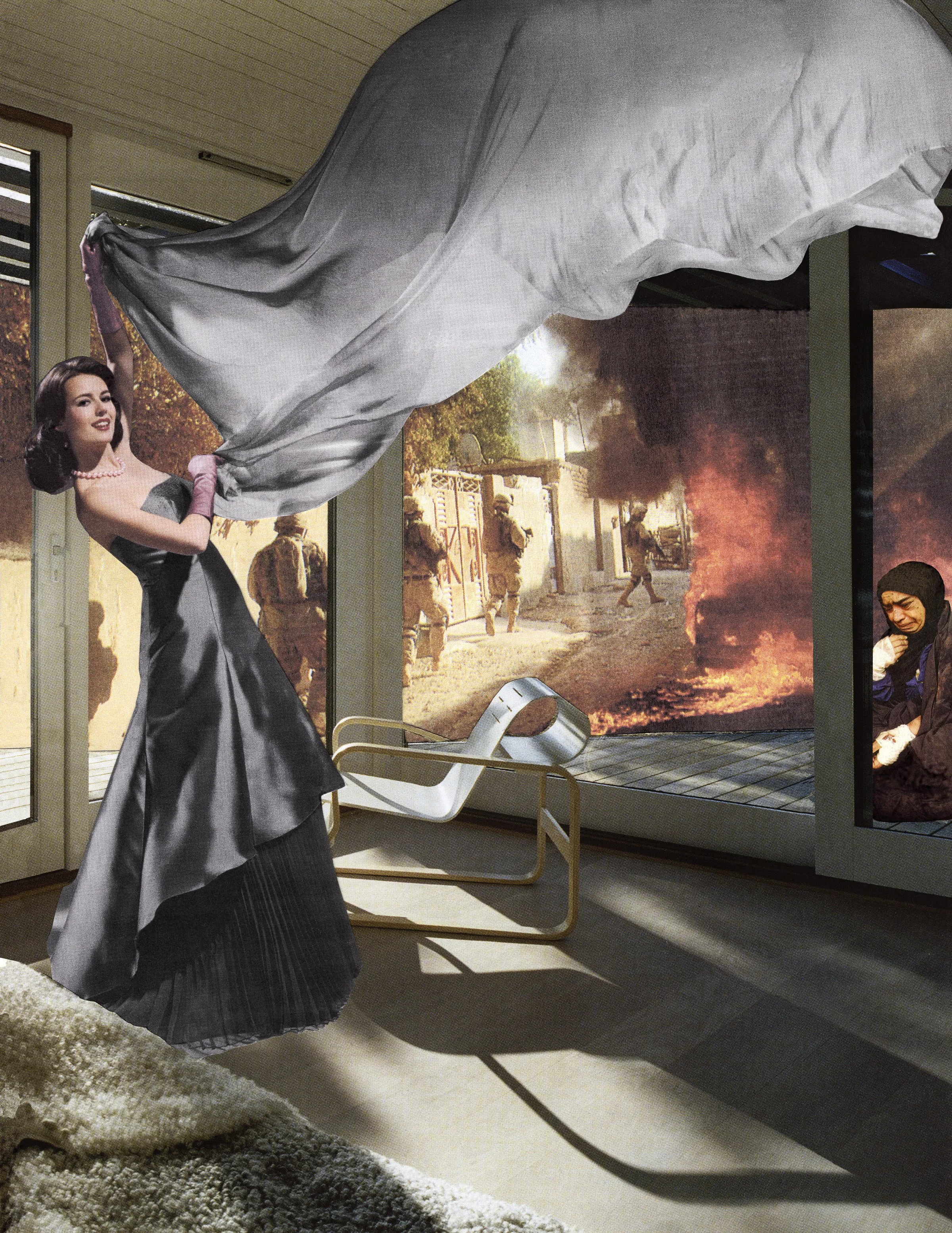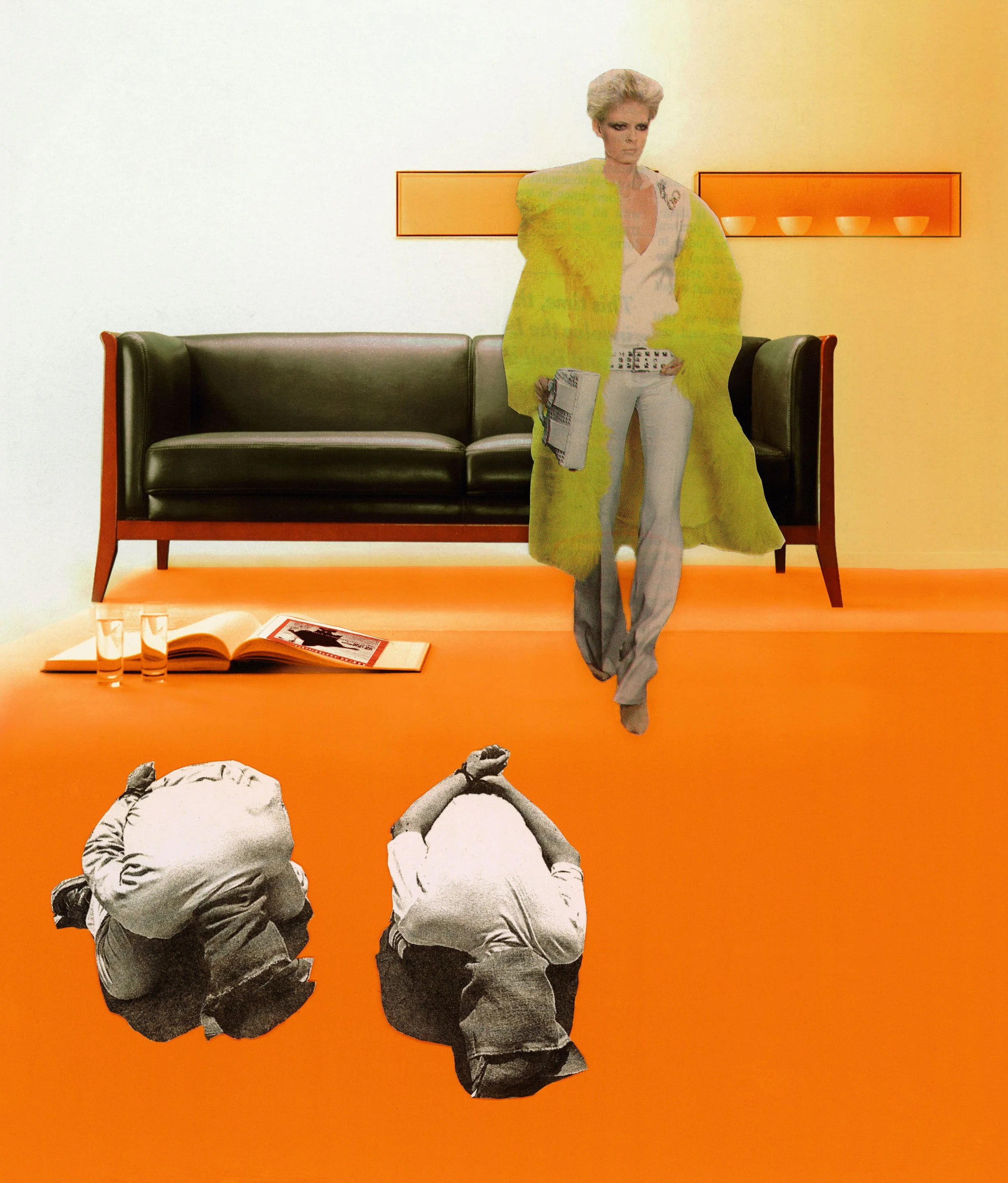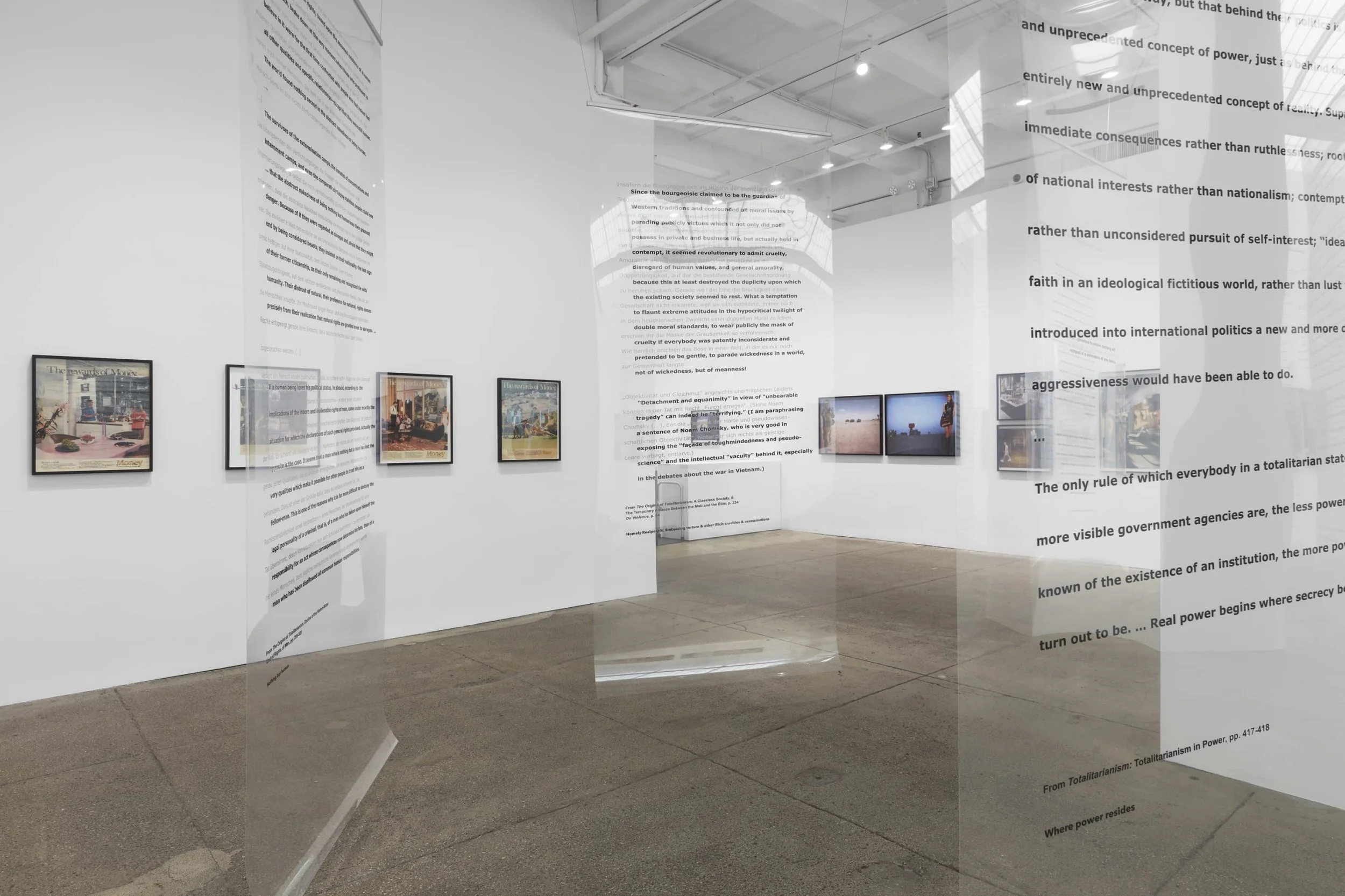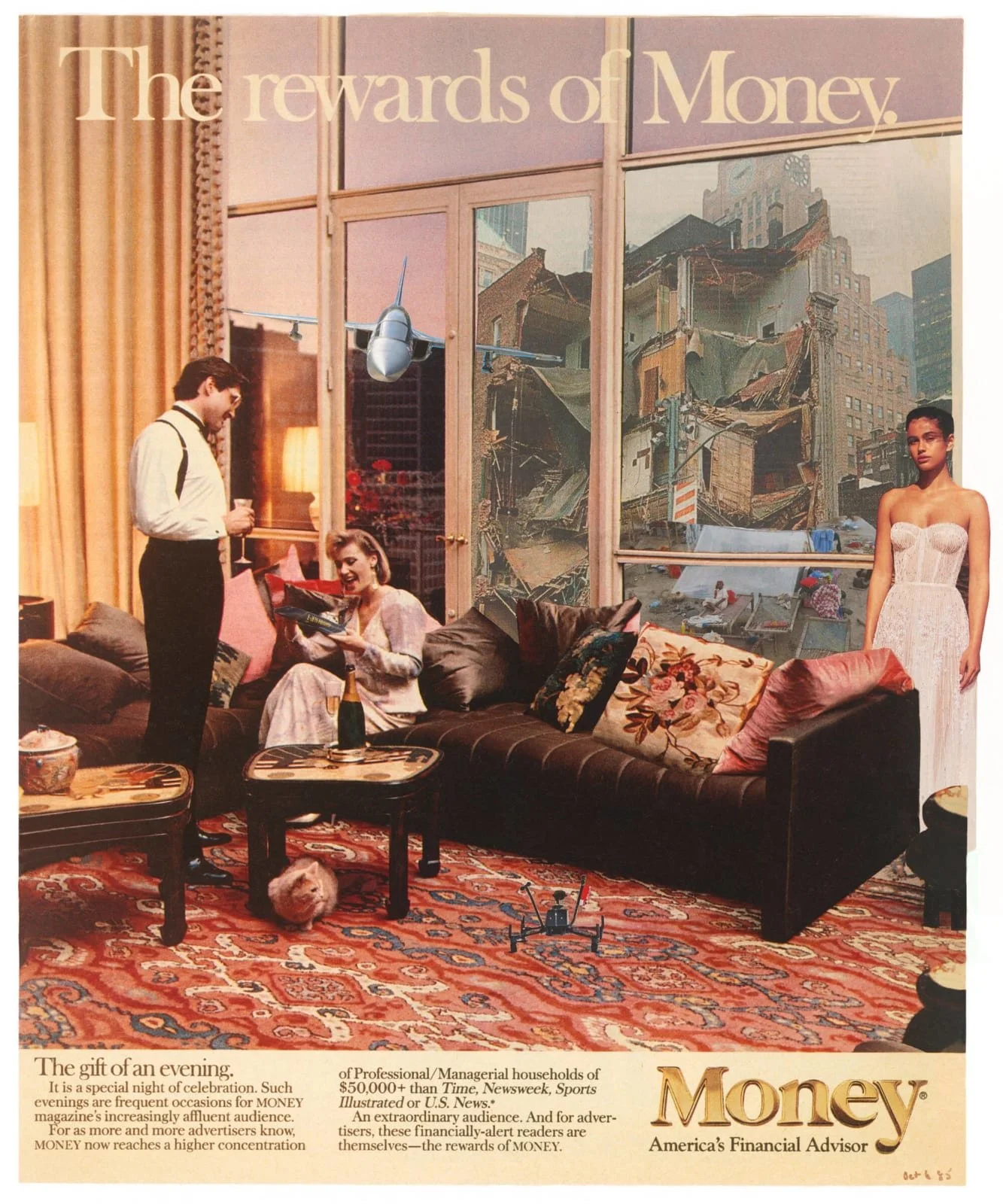By Gregory Eddi Jones, May 10, 2025
At Galerie Lelong, Martha Rosler’s exhibition “Truth is/is Not” begins with a simple choice: insert a quarter into a turnstile to enter the show, or pay a dollar to play Dance Central on an Xbox next to it. It’s a cheeky arrangement, but a loaded proposition on how we as audiences decide to regard information. On one hand, we are entertainment-hungry consumers. On the other, performative participants. Either way, hardly before seeing the work the artist requests we consider our own positioning toward our media-juiced world.
I chose the turnstile and regard my own positioning decidedly as an observer. I’ve scrolled Reddit for years while rarely making comments. I flippantly poke around Instagram with infrequent contributions to the platform myself.
I prefer the position as witness, because oftentimes it feels that being an active participant in these systems means embracing a certain perversion that we might as well say is impossible to escape. It’s a passive defiance, but these systems are what my peers occupy, and I like to be present in the crowd, at least.
“Truth is/is Not” contains many of the iconic works from the collage corner of Rosler’s career, particularly the Vietnam War and post-9/11 years. They include tactics of interweaving images of war with idyllic lifestyle ads from American consumer magazines. The pictures are systems of assessing media, war, capitalism, class, and gender, and consider the frequent points in which ideologies in these topics come into conflict. The antiquated media signatures of the material that she worked with, first in the 60, 70s, then in the early 'aughts, remind us about media’s severe evolutions.
In the earlier stages of Rosler’s career, America was more or less a monocultural society, with most Americans sharing the same feeds of information. Eons seem to have passed since then. Now, we don’t change channels or flip pages so much as we scroll feeds and click buttons. Our options for the platforms on which we perform these tasks is a cornucopia of flat logos and behavior monitoring. Pictures of war are now packaged with options to “like” or “dislike” or whatever else, so we can inform these systems what we prefer to look at.
Over recent decades, the media landscape has quaked under our feet and fragmented into personal islands that each of us occupy. Each of our tastes and preferences and likes and dislikes are learned by information systems, they in turn show us what they calculate will excite us into interacting more, to feed them more information about ourselves; to perpetuate the system and optimize it toward greater efficiency.
There is testament to be paid for the sturdiness of Rosler's core tenets of how social and political stresses interweave with the abundance and luxury of American life. While such time has passed, “Truth is/ is Not” reminds us what aspects of ourselves are subject to change, and what tensions of our collective societies nevertheless persist.
The beauty of collage is its overt embrace of fragmentation, an acknowledgement of conflict between information systems. Rosler’s work in this domain remains prescient in reminding us of the information sparring that underpins nearly every moment of our waking lives. Our identities are largely defined by the media we consume, and our lifestyles are collages of technological interaction.
During most of my look-at-my-phone moments, what I see is usually a combination of global war, domestic politics, economic news, and recommendations for pizza near me. I check to see if a friend responded to my DM. I open my weather app because I feel cold. I take a quick picture of something I want to remember, only to forget why it felt important in the first place. Device escape speaks to a climate rife with anxieties of not wanting to feel left out. To be online today is to be present. Yet, when the battery dies, all we’re left with is a black mirror reflecting only our own faces.
All is to say that much of Martha Rosler’s work reminds me of all these things. Her subject matter is macro in scale, while we ourselves are micro in presence and the attention we provide. Global and national narratives are more personalized. We typically ask first: what does this mean for me?
At the center of the gallery is “Reading Hannah Arendt (Politically) for an American in the 21st Century” an installation made of translucent hanging panels printed with texts by Arendt, a philosopher known for her work on authoritarianism and the loss of shared truth. As we walk through the gallery space, you see Rosler’s other work—and other visitors—through the layers of text. It’s a fitting experience; the crossing of signals and competition for attention.
I didn’t read much of any of Arendt’s texts in the gallery. Their presence felt sufficient, but it would have taken too long, to be honest. My attention is too scattered now in frantic pieces. Too accustomed to little content bits and bites that blare from the great digital scroll. As a writer I have existential doubts about anyone actually reading anything I write myself. If you’ve made it this far, kudos to you.
Gregory Eddi Jones is an artist, writer, and publisher. His photographic work has been published in the British Journal of Photography, Dear Dave, magazine and Foam Magazine, and has contributed writing to Afterimage, Paper Journal, and Unseen Magazine.
MARTHA ROSLER, “HOODED CAPTIVES, from the series HOUSE BEAUTIFUL: BRINGING THE WAR HOME, NEW SERIES, 2004. © MARTHA ROSLER, COURTESY GALERIE LELONG, NEW YORK
MARTHA ROSLER, “IT LINGERS”, 1993. © MARTHA ROSLER, COURTESY GALERIE LELONG, NEW YORK
INSTALLATION VIEW, GALERIE LELONG, NEW YORK, MARTHA ROSLER: TRUTH IS/IS NOT, COURTESY GALERIE LELONG, NEW YORK.
MARTHA ROSLER “FAMILY ROOM from the series THE REWARDS OF MONEY” 1987-88/2022. © MARTHA ROSLER, COURTESY GALERIE LELONG, NEW YORK
MARTHA ROSLER, “RED AND WHITE STRIPES (BAGHDAD BURNING), FROMTHE SERIES HOUSE BEAUTIFUL: BRINGING THE WAR HOME, NEW SERIES” 2004. © MARTHA ROSLER, COURTESY GALERIE LELONG, NEW YORK






